
1908 - 1931
Shivaram Hari Rajguru
Summary
Name:
Years Active:
1925 - 1931Birth:
August 24, 1908Status:
ExecutedClass:
MurdererVictims:
1Method:
ShootingDeath:
March 23, 1931Nationality:
India
1908 - 1931
Shivaram Hari Rajguru
Summary: Murderer
Name:
Shivaram Hari RajguruStatus:
ExecutedVictims:
1Method:
ShootingNationality:
IndiaBirth:
August 24, 1908Death:
March 23, 1931Years Active:
1925 - 1931Date Convicted:
October 7, 1930bio
Shivaram Hari Rajguru was born on 24 August 1908 in Khed, a small town on the banks of the Bhima River near Pune, in present-day Maharashtra. He was born into a Marathi Deshastha Brahmin family to parents Harinarayan Rajguru and Parvati Devi. His father died when Shivaram was only six years old, leaving the family in difficult circumstances. The responsibility of raising the family fell on his elder brother, Dinkar Rajguru, who became a father figure to young Shivaram.
Rajguru received his early education at the village school in Khed and later continued at the New English High School in Pune. From a young age, he demonstrated an adventurous spirit and was deeply influenced by the nationalist sentiment growing across India. He joined the Seva Dal, a youth organization that trained young men in discipline, physical fitness, and nationalist ideals. This early involvement introduced him to revolutionary thought and the importance of self-sacrifice for the cause of independence.
Unlike many of his contemporaries, Rajguru displayed a strong inclination toward direct action rather than passive protest. His fiery temperament and natural marksmanship made him an ideal recruit for revolutionary organizations. Over time, he grew close to members of the Hindustan Socialist Republican Association (HSRA), a group that advocated armed resistance against the British Raj.
murder story
Rajguru’s entry into national prominence is most strongly tied to the events of late 1928. The Simon Commission, set up by the British to discuss constitutional reforms in India, sparked outrage because it did not include a single Indian member. Across the country, protests were organized, and in Lahore, Lala Lajpat Rai, a senior nationalist leader, led a demonstration on 30 October 1928. The protest turned violent when the police, under the orders of Superintendent James Scott, charged the crowd with lathis (batons). Rai was badly injured and later died of a heart attack on 17 November 1928. Nationalists held Scott responsible for his death.
The HSRA, with which Rajguru was closely associated, vowed to avenge Rai’s death. Together with Bhagat Singh, Sukhdev Thapar, and Chandrashekhar Azad, Rajguru helped plot the assassination of James Scott. However, in a tragic twist of mistaken identity, the group targeted and killed John Saunders, a junior Assistant Superintendent of Police, instead of Scott.
On 17 December 1928, Rajguru waited outside the Lahore police station with a revolver. When Saunders emerged on his motorcycle, Rajguru fired the first shot, wounding him. Bhagat Singh then stepped in and shot Saunders multiple times at close range, ensuring his death. As the group fled, Head Constable Channan Singh gave chase but was shot dead by Azad, who was covering their retreat. The assassins escaped Lahore under a well-devised disguise plan that included Bhagat Singh cutting his hair and beard and posing as a young husband with Durga Bhabhi and her infant child, while Rajguru acted as their servant.
Although initially undetected, Rajguru’s association with the HSRA and his role in the Saunders assassination soon became clear to colonial authorities. By April 1929, during the crackdown following the Central Legislative Assembly bombing by Bhagat Singh and Batukeshwar Dutt, Rajguru was identified and arrested as part of the larger Lahore Conspiracy Case. He was listed among the primary accused, alongside Singh and Sukhdev.
The trial was lengthy but heavily biased against the revolutionaries. Witness testimonies, often extracted under pressure, and the confessions of some former HSRA members, provided enough for the British tribunal to sentence Rajguru, Singh, and Sukhdev to death. On 7 October 1930, the verdict was pronounced.
Despite petitions and appeals from Indian leaders, including Mahatma Gandhi, the Viceroy refused to grant clemency. The executions were scheduled for 24 March 1931, but to avoid unrest, the authorities secretly advanced them to 23 March 1931. At 7:30 PM in Lahore Central Jail, Rajguru, Bhagat Singh, and Sukhdev were hanged simultaneously. Their bodies were cremated in secrecy at Hussainiwala, near the Sutlej River, to prevent public gatherings.